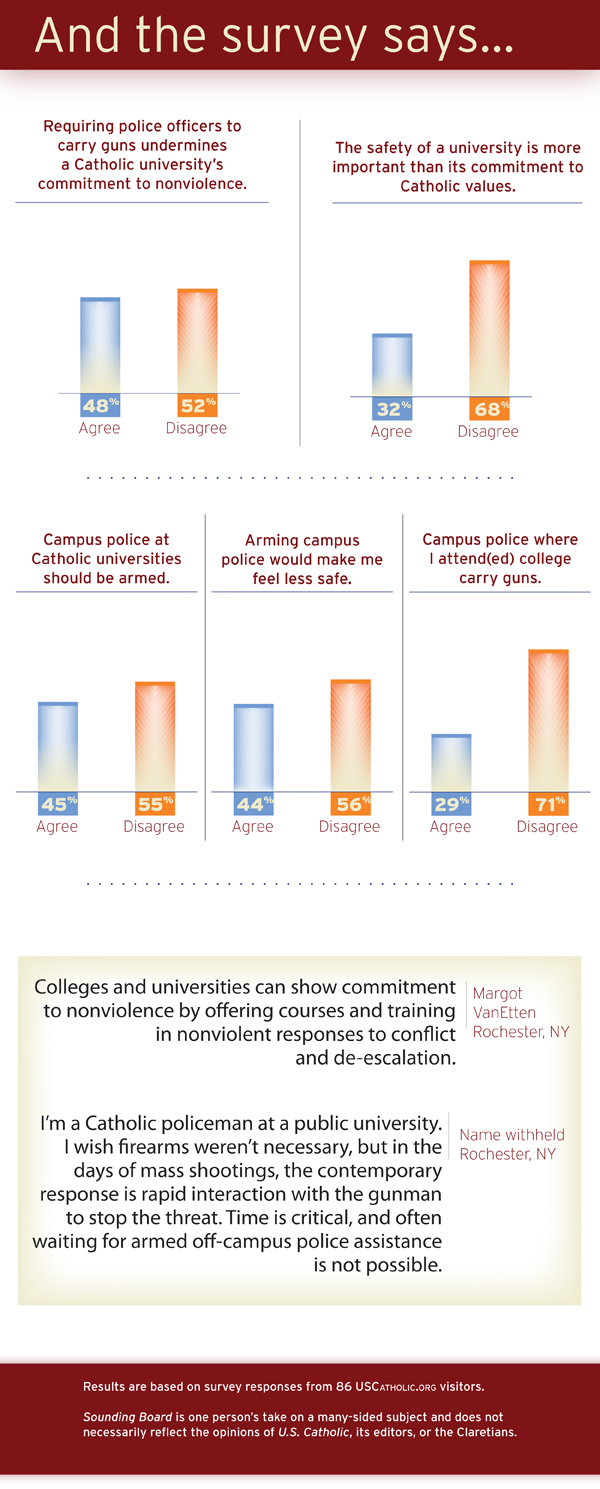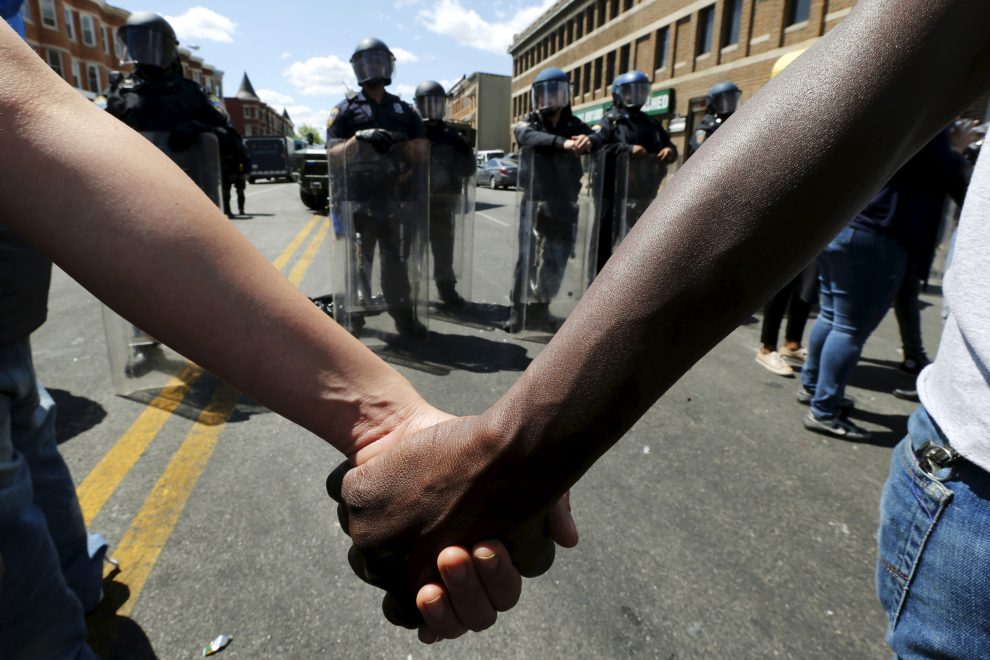In October 2015 Villanova University decided to train and arm a number of its public safety officers to create a small armed police force within the department of public safety.
In the weeks that followed that decision, reactions on campus were varied. There were lively conversations about a lack of inclusiveness in the decision-making process, a lot of talk about why the police needed to be armed, and also an apparent lack of concern for it all. What I found most puzzling was the failure to acknowledge the impact that such a decision would have on the Catholic university’s mission. Even more puzzling was the fact that I could not find evidence that any Catholic university—neither those universities that already had police who are sworn and unarmed nor those who had police who are both sworn and armed—had talked about the connection between safety decisions and their Catholic mission.
I found my own interest in campus safety awakened and wondered how a decision that affects everyone on campus—some more than others—could be made without at least some reference to a Catholic university’s mission of peace and justice. As I explored that question against the backdrop of the many varied opinions that were voiced on campus and on social media, it became clear that people were not talking about the decision to turn some public safety officers into police—giving them greater authority to do things such as issue tickets and make arrests. All the talk was about the choice to arm them. The gun had become a symbol: a symbol of safety and control to some and a symbol of power and potential violence to others.
My sense was that campus safety at Villanova was not going to be better by adding a few guns to a campus already protected by the local police department. But the appearance of having accepted a guns-will-make-us-safe mentality seemed to undermine the credibility of the university’s Catholic commitment to nonviolence. Guns are all about law enforcement, not about developing community or seeking reconciliation.
Instead of second-guessing a past decision, I realize this underlying contrast between a commitment to peace and a decision to rely on lethal means offers a good opportunity to recognize the relationship between Catholic social teachings and everyday practicalities. Reflecting on the implications of this reliance on lethal means, therefore, is a good way to study how the mission of Catholic universities should be an integral part of ongoing evaluation and future decision making.
The importance of peacemaking to the mission of a Catholic university is clear—as St. Augustine wrote to a Roman official, “Your mission is to prevent the shedding of blood. You have the privilege of averting that calamity which others are under the necessity of producing.” Arming campus police would mean the officers would have to be ready to use lethal means, that is, to kill. The Catholic tradition is clear that life is sacred and possesses inherent dignity, yet it also permits the use of force, including lethal force, in defense of life. But only as a last resort.
Catholic universities are committed to change that seeks right relationships and promotes justice and charity in the widest possible political and social contexts. Achieving their mission requires all sorts of collaboration in the classroom, on campus, and in service to the surrounding communities. Educating for justice, in other words, is a complex challenge, and the daily experience on campus plays an important role. Campuses should, as G. F. Powers in “Catholic Peacebuilding” in A Vision of Justice: Engaging Catholic Social Teaching on the College Campus (Michael Glazier) believes, put into place “structures of cooperative security that both promote authentic human development and the common good.”
So what is the common good when seen through the eyes of the most vulnerable on campus? How is a Catholic commitment to peacemaking, to nonviolence, and to the seamless garment of life to be applied, and how can any Catholic university fail to recognize the importance of emphasizing that the police are members of the university community, not safety overseers?
Everyone on a college campus should learn to be responsible for safety, not just campus police. But in giving some members of the community guns, special status and power are assigned to a select few. The underlying concern is that reliance on guns for safety has the potential of diminishing or making suspect aspects of the Catholic message—making it more difficult for the police to see themselves as belonging to the campus community rather than being figures of authority who are tempted to be “other” or to see the rest as “others.” Guns are intimidating, not signs of peace and reconciliation. Campus police should be part of the community, not mere observers of its members. Campus safety and security is fundamentally about relationships and trust. The introduction of lethal weapons to campus runs counter to that reality, especially in a world where, as R. Balko in Rise of the Warrior Cop: The Militarization of America’s Police Forces (PublicAffairs) states, military-style policing has grown in importance.
An increasingly important movement toward community policing—so necessary with the use of so much excessive force across our nation—is very much in line with the mission of a Catholic university. At Cardinal Stritch University in Wisconsin, for example, an environment of safe learning for all is promoted on campus. The department of security operates 24/7, providing students and staff with a variety of services. A crisis communication plan is in place to ensure everyone on campus is notified of impending emergencies in a timely manner. All crimes reported to the office are investigated thoroughly by officers, and the campus security director attends monthly meetings with local law enforcement officers to discuss area crime and prevention techniques. While the officers cannot make arrests, they work with local police departments to keep the campus safe.
A decision to arm campus police where no imminent danger has been identified not only undermines this feeling of communal responsibility but also exaggerates the fear of a potential event. To say that arms are needed to protect life not only gives too much importance to guns, it also burdens those who are armed, setting them apart and setting them up to be reactive. In the context of community policing the role of the campus police department should be proactive, providing programs designed to enhance personal safety and to prevent and deter crime, and not just to respond to incidents. Officers who see their role from within the life and rhythm of the campus community are less likely to act out of fear. In addition, commitment to knowing and working with a community that has sought to increase its diversity will make police departments less likely to repeat the historical mistreatment that minorities have too often suffered.
Taking advantage of a well-trained and professional campus police department means that the officers should be selected and trained in developing community relations, not just on the basis of previous police experience or an ability to succeed at a police academy. Their demeanor and professionalism, in other words, should be oriented toward teaching justice and community development, not in fueling attitudes of fear and insecurity. They should not be set apart from the community by being armed but by their ability to diffuse difficult moments and to understand and interact face-to-face with the diverse faculty, staff, and students.
Because we live in a time in which racism, division, and polarization are all too common, the means to overcome those realities on a Catholic university campus—or any campus, for that matter—is not the addition of arms to the qualifications of campus police. The police ought to be in the forefront of solving the problems that lead people to act in bad ways, not just required to respond to crises, to make arrests, or to enforce law. Strategies for community policing, in other words, are not more important than the spiritual and ethical dimensions of Catholic identity.

This article also appears in the February 2017 issue of U.S. Catholic (Vol. 82, No. 2, pages 24–27).
Image: iStock.com/iso_petrov












Add comment